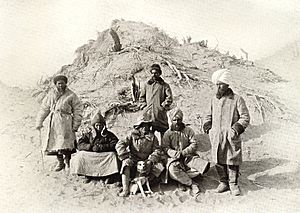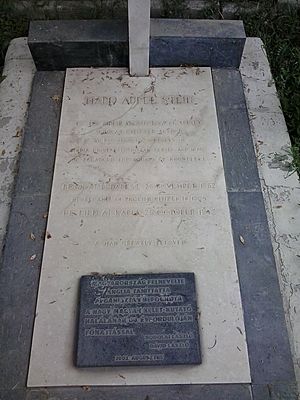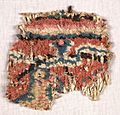Aurel Stein facts for kids
Quick facts for kids
Sir Aurel Stein
|
|
|---|---|

Stein in 1909
|
|
| Born |
Stein Márk Aurél
26 November 1862 |
| Died | 26 October 1943 (aged 80) |
| Citizenship | Hungarian (birth) / British (naturalised) from 1904 |
| Alma mater | University of Tübingen |
| Scientific career | |
| Fields | Archaeology |
| Influences | Xuanzang; Sven Hedin |
Sir Marc Aurel Stein (born Márk Aurél Stein; 26 November 1862 – 26 October 1943) was a famous Hungarian-born British archaeologist. He was best known for his exciting explorations and discoveries in Central Asia. He also worked as a professor at universities in India.
Stein was also an expert in many other fields. He was an ethnographer (someone who studies cultures), a geographer, a linguist (language expert), and a surveyor (someone who maps land). His huge collection of books and old writings from the Dunhuang caves is very important. These help us learn about the history of Central Asia, and the art and literature of Buddhism. He wrote several books about his journeys and discoveries, including Ancient Khotan, Serindia, and Innermost Asia.
Contents
Early Life and Learning
Stein was born in Budapest, Hungary. His parents were Náthán Stein and Anna Hirschler. The family spoke German and Hungarian at home. Stein went to schools in Budapest where he learned many languages. He became very good at Greek, Latin, French, and English.
He then went to universities in Vienna, Leipzig, and Tübingen. He studied Sanskrit (an ancient Indian language) and Persian. He earned his PhD from Tübingen in 1883.
In 1884, he moved to England to study more about languages and archaeology from the East. In 1887, Stein went to India. He worked at the University of the Punjab and later became the Principal of Oriental College, Lahore. During this time, a library of 5000 rare Sanskrit writings was set up under his guidance.
Amazing Expeditions
How the Journeys Began
Stein was inspired by a book called Through Asia by Sven Hedin in 1898. He wanted to find and study ancient treasures in Central Asia. He asked for help from Rudolf Hoernle, another scholar. Hoernle was excited because he had already found some very old writings.
Hoernle suggested that Stein ask the governments of Punjab and India for permission and money. Stein quickly sent a plan. Hoernle helped him by talking to the officials. Within weeks, Stein's plan was approved. In 1899, he received the official approval and money for his first big trip. He later got support for more expeditions to places like Chinese Turkestan and Tibet.
Stein's Four Great Journeys
Stein made four main expeditions to Central Asia. These were in 1900–1901, 1906–1908, 1913–1916, and 1930. He uncovered amazing treasures from a great civilization that was almost forgotten.
One important discovery from his first trip was in the Taklamakan Desert oasis of Dandan Oilik. Here, he found many ancient items. During his third trip, he dug at Khara-Khoto. He also explored the Pamir Mountains. He was looking for the lost Stone Tower. This tower was mentioned by an ancient scholar named Claudius Ptolemy. It was said to be the halfway point of the Silk Road.
The British Library has a huge collection of writings from Stein's travels. These include Chinese, Tibetan, and Tangut manuscripts. He also found writings in languages like Khotanese, Uyghur, and Sogdian. Stein discovered writings in the previously lost Tocharian languages in the Tarim Basin. He also recorded many archaeological sites in Iran and Balochistan.
The Diamond Sutra Discovery
Stein's most famous discovery happened in 1907. This was at the Mogao Caves, also known as the "Caves of the Thousand Buddhas," near Dunhuang. Here, he found a printed copy of the Diamond Sutra. This is the world's oldest known printed text, dating back to AD 868.
He also found about 40,000 other scrolls. He managed to get these by gaining the trust of the caretaker. He took 24 cases of manuscripts and 4 cases of paintings and relics. He was honored for his work. However, some people in China called him a "burglar" and protested. Others believed his actions helped scholars learn more about these ancient treasures. His discovery also inspired other explorers from France, Russia, Japan, and China to visit the caves.
During his 1906–1908 journey, Stein explored the Kunlun Mountains. He suffered from frostbite and lost several toes on his right foot.
When he was not on expeditions, Stein often lived in a tent in a beautiful meadow called Mohand Marg in India. Years earlier, he translated an important historical text called Rajatarangini from Sanskrit into English while staying there. A special stone was put up in Mohand Marg in 2017 to remember him.
Personal Life
Stein never married. He was always joined by his loyal dog, named "Dash." He had seven different dogs named Dash throughout his life! He became a British citizen in 1904. Stein passed away in Kabul, Afghanistan, on 26 October 1943. He is buried there in the Sherpur Cantonment.
The Great Game and Discoveries
Stein and other explorers like Sven Hedin and Francis Younghusband were part of something called the "Great Game". This was a competition between the British and Russian Empires. They both wanted more influence in Central Asia. These explorers helped fill in the "blank spots" on maps. They also found valuable information and created "spheres of influence" for archaeological exploration. This was similar to how they created political influence.
The ancient art objects Stein collected are now in several museums. You can find them at the British Museum, the British Library, the Srinagar Museum, and the National Museum, New Delhi.
Honours and Awards
Stein received many awards and honours during his life.
- In 1909, he received the Founder's Medal from the Royal Geographical Society. This was for his wide explorations in Central Asia and his archaeological work.
- He also received several gold medals from different societies. These included the Royal Asiatic Society of Bombay (1909), the Société de Géographie (1923), the Royal Asiatic Society of Great Britain and Ireland (1932), and the Society of Antiquaries of London (1935).
- In 1934, he was given the Huxley Memorial Medal.
He was also recognized by the British government:
- In 1910, he was made a Companion of the Order of the Indian Empire (CIE).
- In 1912, he was promoted to Knight Commander of the Order of the Indian Empire (KCIE). This meant he was given the title "Sir."
Many universities also gave him honorary degrees:
- University of Oxford (Doctor of Letters, 1909)
- University of Cambridge (Doctor of Science, 1910)
- University of St Andrews (Doctor of Laws, 1939)
In 1919, Stein became a foreign member of the Royal Netherlands Academy of Arts and Sciences. In 1921, he was elected a Fellow of the British Academy (FBA).
Images for kids
See also
 In Spanish: Marc Aurel Stein para niños
In Spanish: Marc Aurel Stein para niños
- Three hares
- Sándor Kőrösi Csoma
- Ármin Vámbéry
- Amluk-Dara stupa






